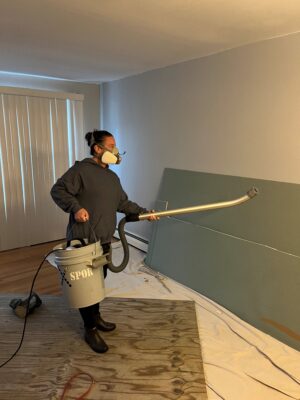
Many property owners consider mold one less problem that they have to worry about as winter approaches. Colder temperatures and lower humidity kill it, right?
Not right. While mold is more closely associated with spring and fall and the rains these temperate seasons can bring, it lurks in the extreme seasons, too, particularly with the advent of climate change. In Westchester and Fairfield counties, we’ve recently come off a summer in which it seemed to rain every other day and virtually every weekend. Late fall always brings a torrent of leaves that trap moisture. Winter can mean cold – and damp – air. (Predictions for the coming El Niño winter are all over the place, with some saying we will have a snowier winter than last year while others say it will be warmer and drier. “Though warmer temperatures may prevail again in the Northeast, more nor’easters could hit major East Coast cities this winter,” The New York Times writes. )
So property owners are smart to be vigilant about mold’s threat to hearth and health. Jim Oliver – co-founder (with Laura Champagne) of Natural Home Solutions LLC, a mold remediation company serving Connecticut, Massachusetts, Vermont and New Hampshire – advises property managers, landlords and homeowners alike to take the following measures from lodgify.com to maintain mold-free properties:
- Keep water out by routinely inspecting the outside of the property for foundation problems, poorly installed windows, clogged gutters, roof concerns, poor drainage and storm damage;
- Keep indoor humidity levels between 30% and 50%. Use a portable dehumidifier in areas that are consistently above 60% humidity. Consider a HVAC-compatible, whole-house dehumidifier as well. Prices range from $1,300 to $2,800;
- Install bathroom fans and attic vents to remove moisture;
- Use mold-resistant building materials like wallboard, paint primer and porcelain. Avoid carpeting basements. In other areas, rugs with a higher pile are more prone to collecting mold and mildew than short-pile rugs;
- Winterize plumbing and shut off water to appliances and outside faucets in the cold weather. This is crucial to preventing not only mold but cracked, frozen or bursting pipes.
If a property shows signs of contamination, Natural Home Solutions starts by inspecting areas of concern, measures ATP (adenosine triphosphate) to detect microorganisms and performs air quality or tape tests to collect air and/or surface samples. An independent laboratory then analyzes the samples and, if mold is confirmed, determines the source and type of mold.
“If you require mold remediation, we eliminate contaminants with EnzyCleanse,, an effective organic solution that is nontoxic and safe around humans or pets,” Champagne said. The EnzyCleanse fogger produces micro-droplets small enough to penetrate contaminated surfaces and reach areas like wall cavities to break down mold roots and spores, thus eliminating contaminations. EnzyCleanseT also continues working to prevent mold growth long after the treatment.
“When we test or treat a property for mold contamination, we comply with applicable government and health department standards and certifications,” she added. “What’s more, contaminants may not be limited to mold but also (include) urine, feces and sweat as well.”
This information is particularly key for commercial property managers, who are a resident’s first contact for mold contamination complaints. It’s often their duty to evaluate a problem and implement solutions.
Individual landlords are also responsible for identifying and resolving unhealthy or unsafe conditions on their property. When left unresolved, mold sometimes sickens occupants, especially those with existing respiratory issues. It often also causes visible and hidden structural deterioration, and it can damage personal property.
“If you delay necessary remediation efforts, you may become legally responsible for mold-related illnesses or property damage,” Oliver added. “If a resident pursues litigation despite your best efforts, our professional testing process documents important evidence. It can also provide an expert opinion to help your attorney structure a defense.”
Professional inspection and testing help identify and document contamination sources as well. Sometimes a tenant or renter is responsible for allowing mold to thrive due to moisture from a resident’s overflowing sink, residential pets or rain entering an open window.
“In addition to inspection, testing and remediation services, we help educate residents and association members about mold and its consequences,” Champagne said. “We explain how mold occurs and discuss its potential for injury and damage. When residents understand how it grows and contaminates their living spaces, they assume some of the responsibility for prevention and also for adverse outcomes.”
Sometimes problems arise not due to neglect but circumstances. “When properties are left unattended for a period of time, such as seasonal homes or businesses, turbulent weather may have caused issues that owners are unaware of, which can both surprise and overwhelm them,” added Champagne. “Natural Home Solutions can be an important part of their resolution team.”
Here as elsewhere the proverbial ounce of prevention is worth a pound of cure. By the time a renter or property owner notices a moldy smell, mold contamination already has the potential to cause harm. Regular professional testing can detect mold contamination early enough to prevent serious problems and avoid costly property repairs.
“When property owners fail to fix mold problems in a timely manner, they become more costly over time,” Champagne added. “To keep your…home expenses in check, a professional is your best ally to provide timely solutions to minimize your risks of financial loss.”




















